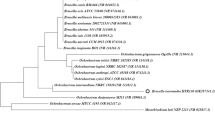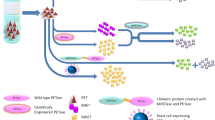Abstract
Degradation of pendimethalin by microorganisms is an approach seeking more attention nowadays. This study aims to isolate a new strain of Planococcus, which is capable of degrading pendimethalin from the soil in rice field. Identification of this coccus bacterium was done by phylogenetic analysis of 16S rRNA gene sequence. Strain PD6 was found to grow potentially on pendimethalin supplemented minimal salt medium and degraded 50 mg L−1 pendimethalin in monosubstrate system. Fourier transform infrared (FTIR) spectroscopy was performed to check degradation of pendimethalin by Planococcus, which was demonstrated by changing chemical bonding and stretching patterns. This study was further extended to predict possible first enzyme of pendimethalin-degradation pathway. Molecular docking was performed to check efficient binding of dehydrogenase with pendimethalin. This strain of Planococcus degraded pendimethalin with relatively high efficiency in minimal salt media and is presented as another possible bacterium other than species of Bacillus and Pseudomonas which are already demonstrated as potential in vitro pendimethalin-degrading bacteria. Moreover, docking reveals that dehydrogenases having more chance to prove as first regulatory enzyme of pendimethalin-degradation pathway.
Graphical abstract







Similar content being viewed by others
Data availability
The data that support the findings of this study are openly accessible on request.
References
Jape P, Maheshwari V, Chaudhari A. Microbial degradation of nitroaromatic herbicide: pendimethalin. In: Microbial interventions in agriculture and environment. Singapore: Springer; 2019. p. 531–44.
Millhollon RW. Preemergence control of itchgrass (Rottboellia cochinchinensis) and johnsongrass (Sorghum halepense) in sugarcane (Saccharum spp hybrids) with pendimethalin and prodiamine. Weed Sci. 1993;41:621–6.
Taylor-Lovell S, Wax LM, Bollero G. Preemergence flumioxazin and pendimethalin and postemergence herbicide systems for soybean (Glycine max). Weed Technol. 2002;16:502–11.
Kole RK, Saha J, Pal S, Chaudhuri S, Chowdhury A. Bacterial-degradation of the herbicide pendimethalin and activity evaluation of its metabolites. Bull Environ Contam Toxicol. 1994;52:779–86.
Ma JY, Wang SF, Wang PW, Ma LJ, Chen XL, Xu RF. Toxicity assessment of 40 herbicides to the green alga Raphidocelis subcapitata. Ecotoxicol Environ Saf. 2006;63:456–62.
Ramakrishna M, Mohan SV, Shailaja S, Narashima R, Sarma PN. Identification of metabolites during biodegradation of pendimethalin in bioslurry reactor. J Hazard Mater. 2008;151:658–61.
Smith MAK. Comparing weed and crop seedling response to pre-emergence pendimethalin application in Corchorus olitorius and Abelmoschus esculentus. Crop Prot. 2006;25:1221–6.
Kulshrestha G, Singh SB, Lal SP, Yaduraju NT. Effect of long-term field application of pendimethalin: enhanced degradation in soil. Pest Manag Sci. 2000;56:202–6.
Vommaro ML, Giulianini PG, Giglio A. Pendimethalin-based herbicide impairs cellular immune response and haemocyte morphology in a beneficial ground beetle. J Insect Physiol. 2021;131:104.
Garcia-German S, Bardaji I, Garrido A. New pesticides regulation: potential economic impacts of the withdrawal of pendimethalin in horticultural crops. Span J Agric Res. 2014;12:29–43.
Barriuso E, Houot S, Serra-Wittling C. Influence of compost addition to soil on the behaviour of herbicides. Pestic Sci. 1997;49:6–75.
Capel PD, Lin M, Wotzka PJ. Wet atmospheric deposition of herbicides in Minnesota, 1989–94 (Vol. 97, No. 4026). US Department of the Interior, US Geological Survey. 1998.
Racke KD. Herbicides for turfgrass pest management: uses and environmental issues. Fate and management of turfgrass chemicals 743. American Chemical Society; 2000. p. 45–64.
Staveley JP, Smrchek JC. Algal toxicity test. In: Blaise C, Férard JF, editors. Small-scale freshwater toxicity investigations. Dordrecht: Springer; 2005.
Pikula KS, Zakharenko AM, Aruoja V, Golokhvast KS, Tsatsakis AM. Oxidative stress and its biomarkers in microalgal ecotoxicology. Curr Opin Toxicol. 2019;13:8–15.
Gomathi Devi LN, Krishnamurthy G. Photocatalytic degradation of the herbicide pendimethalin using nanoparticles of BaTiO3/TiO2 prepared by gel to crystalline conversion method: a kinetic approach. J Environ Sci Health B. 2008;43:553–61.
Han Y, Tang Z, Bao H, Wu D, Deng X, Guo G, Dai B. Degradation of pendimethalin by the yeast YC2 and determination of its two main metabolites. RSC Adv. 2019;9:491–7.
Abdelbagi AO, Hammad AMA, Elsheikh EAE, Elsaid OE, Hur JH. Biodegradation of endosulfan and pendimethalin by three strains of bacteria isolated from herbicides-polluted soils in the Sudan. Appl Biol Chem. 2017;60:287–97.
Hug LA, Beiko RG, Rowe AR, Richardson RE, Edwards EA. Comparative metagenomics of three Dehalococ-coides -containing enrichment cultures: the role of the non-dechlorinating community. BMC Genom. 2012;13:327.
McCutcheon JP, Von Dohlen CD. An interdependent metabolic patchwork in the nested symbiosis of mealybugs. Curr Biol. 2011;21:1366–72.
Stolyar S, Van Dien S, Hillesland KL, Pinel N, Lie TJ, Leigh JA, Stahl DA. Metabolic modeling of a mutualistic microbial community. Mol Syst Biol. 2007;3:92.
Mulholland AJ. Modelling biological systems. In: Hinchliffe A, editor. RSC specialist periodical reports ’chemical modelling and theory, vol. 4. Royal Society of Chemistry; 2006. p. 23–68.
Lonsdale R, Ranaghan KE, Mulholland AJ. Computational enzymology. Chem Comm. 2010;46:2354–72.
Handy RD, Cornelis G, Fernandes T, Tsyusko O, Decho A, Sabo-Attwood T, Metcalfe C, Steevens JA, Klaine SJ, Koelmans AA, Horne N. Ecotoxicity test methods for engineered nanomaterials: practical experiences and recommendations from the bench. Environ Toxcol Chem. 2012;31:15–31.
Waterbury JB. The cyanobacteria—isolation, purification and identification. The prokaryotes. 2006;4:1053–73.
Potts M, Friedmann EI. Effects of water stress on cryptoendolithic cyanobacteria from hot desert rocks. Arch Microbiol. 1981;130:267–71.
Trivedi N, Tandon S, Dubey A. Fourier transform infrared spectroscopy (FTIR) profiling of red pigment produced by Bacillus subtilis PD5. Afr J Biotech. 2017;16:1507–12.
Tamura K, Peterson D, Peterson N, Stecher G, Nei M, Kumar S. MEGA5: molecular evolutionary genetics analysis using maximum likelihood, evolutionary distance, and maximum parsimony methods. Mol Biol Evol. 2011;28:2731–9.
Thomsen R, Chistensen MH. Mol dock: a new technique for high-accuracy molecular docking. J Med Chem. 2006;49:3315–21.
Wojcieszyńska D, Domaradzka D, Hupert-Kocurek K, Guzik U. Enzymes involved in naproxen degradation by Planococcus sp. S5. Pol J Microbiol. 2016;65:177–82.
Choi JH, Im WT, Liu QM, Yoo JS, Shin JH, Rhee SK, Roh DH. Planococcus donghaensis sp. nov., a starch-degrading bacterium isolated from the East Sea. South Korea Int J Syst Evol. 2007;57:2645–50.
Domaradzka D, Guzik U, Wojcieszyńska D. Biodegradation and biotransformation of polycyclic non-steroidal anti-inflammatory drugs. Rev Environ Sci Biotechnol. 2015;14:229–39.
Arensberg P, Hemmingsen VH, Nyholm N. A miniscale algal toxicity test. Chemosphere. 1995;30:2103–15.
Pei ZT, Xu RR, Liu HY, Wang WQ, Zhang M, Zhang LL, Zhang J, Wang WQ, Yu R, Sun LW. Development and application of a novel whole sediment toxicity test using immobilized sediment and Chlorella vulgaris. Ecotoxicol Environ Saf. 2020;189: 109979.
Cid Á, Prado R, Rioboo C, Suarez-Bregua P, Herrero C. Use of microalgae as biological indicators of pollution: looking for new relevant cytotoxicity endpoints. In: Johnsen MN, editor. Microalgae: biotechnology, microbiology and energy. New York: Nova Science Publishers; 2012. p. 311–23.
Benomar S, Ranava D, Cárdenas ML, Trably E, Rafrafi Y, Ducret A, Hamelin J, Lojou E, Steyer JP, Giudici-Orticoni MT. Nutritional stress induces exchange of cell material and energetic coupling between bacterial species. Nat Commun. 2015;6:1–10.
Liu Z, He Z, Huang H, Ran X, Oluwafunmilayo AO, Lu Z. pH stress-induced cooperation between Rhodococcus ruber YYL and Bacillus cereus MLY1 in biodegradation of tetrahydrofuran. Front Microbiol. 2017;8:2297.
Huang H, Yu H, Qi M, Liu Z, Wang H, Lu Z. Enrichment and characterization of a highly efficient tetrahydrofuran-degrading bacterial culture. Biodegradation. 2019;30:467–79.
Nisenbaum M, Corti-Monzón G, Villegas-Plazas M, Junca H, Mangani A, Patat ML, Murialdo SE. Enrichment and key features of a robust and consistent indigenous marine-cognate microbial consortium growing on oily bilge wastewaters. Biodegradation. 2020;31:91–108.
Kočárek M, Artikov H, Voříšek K, Borůvka L. Pendimethalin degradation in soil and its interaction with soil microorganisms. Soil Water Res. 2016;11:213–9.
Kulshrestha G, Singh SB. Influence of soil moisture and microbial activity on pendimethalin degradation. Bull Environ Contam Toxicol. 1992;48:269–74.
Luks AK, Zegarski T, Nowak KM, Miltner A, Kästner M, Matthies M, Schäffer A. Fate of pendimethalin in soil and characterization of non-extractable residues (NER). Sci Total Environ. 2021;753: 141870.
Abdurruhman A, Abdelbagi A, Ahmed A. Biodegradation of pendimethalin and atrazine by Pseudomonas pickettii isolated from herbicides polluted soil under laboratory conditions. J Biotechnol Sci Res. 2015;2:94–102.
Ni H, Li N, Qian M, He J, Chen Q, Huang Y, Wang F. Identification of a novel nitroreductase LNR and its role in pendimethalin catabolism in Bacillus subtilis Y3. J Agric Food Chem. 2019;67:12816–23.
Abdel-Moteleb EB, Hasan NE. Dissipation of pendimethalin by Bacillus megaterium. J Plant Pathol. 2013;4:463–72.
Ni H, Li N, Qiu J, Chen Q, He J. Biodegradation of pendimethalin by Paracoccus sp. P13. Curr Microbiol. 2018;75:1077–83.
Trivedi N, Dubey A. Degradation studies of pendimethalin by indigenous soil bacterium Pseudomonas strain PD1 using spectrophotometric scanning and FTIR. Arch Microbiol. 2021;203:4499–507.
Strandberg M, Scott-Fordsmand JJ. Effects of pendimethalin at lower trophic levels—a review. Ecotoxicol Environ Saf. 2004;57:190–201.
Ni H, Yao L, Li N, Cao Q, Dai C, Zhang J, He J. Biodegradation of pendimethalin by Bacillus subtilis Y3. J Environ Sci. 2016;41:121–7.
Kocur M, Zdena P, Hodgkiss W, Martinec T. The taxonomic status of the genus Planococcus Migula 1894. Int J Syst Evol Microbiol. 1970;20:241–8.
Waghmode S, Suryavanshi M, Sharma D, Satpute SK. Planococcus species–an imminent resource to explore biosurfactant and bioactive metabolites for industrial applications. Front Bioeng Biotechnol. 2020;8:996.
Yang R, Zhang B, Wang J, Tai X, Sun H, Zhang G, Liu G. Planococcus lenghuensis sp. nov., an oil-degrading bacterium isolated from petroleum-contaminated soil. Antonie Leeuwenhoek. 2020;113:839–50.
Desouky SE, El-Gamal MS, Barghoth MG. Aerobic biodegradation of BTX by halophilic Planococcus sp. strain TS1 isolated from Egypt. J Adv Biol. 2015;4:1–13.
Ramalho TC, de Castro AA, Silva DR, Silva MC, Franca TCC, Bennion JB, Kuca K. Computational enzymology and organophosphorus degrading enzymes: promising approaches toward remediation technologies of warfare agents and herbicides. Curr Med Chem. 2016;23:1041–61.
Lee HS, Jo S, Lim HS, Im W. Application of binding free energy calculations to prediction of binding modes and affinities of MDM2 and MDMX inhibitors. J Chem Info Mod. 2012;52:1821–32.
Elsaid OEG, Abdelbagi AO, Elsheikhc EAE. Microbial degradation of endosulfan in carbon free media and selective media. Res J Agric Biol Sci. 2010;6:257–62.
Kamrin MA. Herbicide profiles: toxicity, environmental impact, and fate. CRC Press; 1997.
Karn SK, Reddy MS. Degradation of 2, 4, 6-trichlorophenol by bacteria isolated from secondary sludge of a pulp and paper mill. J Gen Appl Microbiol. 2012;58:413–20.
Wang S, Arnold WA. Abiotic reduction of dinitroaniline herbicides. Water Res. 2003;37:4191–201.
Acknowledgements
The scientific discussion with Dr. A.K. Verma (Department of Biochemistry CBSH, GBPUAT, India) and Dr. Anita Sharma (Department of Microbiology CBSH, GBPUAT, India) are gratefully acknowledged.
Funding
The work was partially supported by DST (Department of Science and Technology)—FIST (Fund for Improvement of S&T) India.
Author information
Authors and Affiliations
Contributions
Research problem design, experiment design and objectives were decided by Dr. Ashutosh Dubey. Experimentation and data analysis was done by Dr. Neha Trivedi. Both the authors have equal contribution in manuscript writing and further editing.
Corresponding author
Ethics declarations
Conflict of interest
The authors declare that they have no conflict of interest.
Ethical approval and consent to participate
The authors declare that they have no known competing interests or personal relationships that could have appeared to influence the work reported in this research article. We declare that we do not have human participants, human data or human issue.
Rights and permissions
Springer Nature or its licensor (e.g. a society or other partner) holds exclusive rights to this article under a publishing agreement with the author(s) or other rightsholder(s); author self-archiving of the accepted manuscript version of this article is solely governed by the terms of such publishing agreement and applicable law.
About this article
Cite this article
Trivedi, N., Dubey, A. Biodegradation analysis of pendimethalin by Planococcus citreus strain PD6 using FTIR and further in silico characterization for dehydrogenase as potential regulatory enzyme of degradation pathway. Syst Microbiol and Biomanuf 3, 719–729 (2023). https://doi.org/10.1007/s43393-022-00142-3
Received:
Revised:
Accepted:
Published:
Issue Date:
DOI: https://doi.org/10.1007/s43393-022-00142-3




